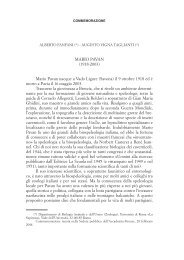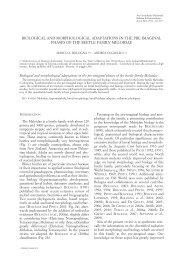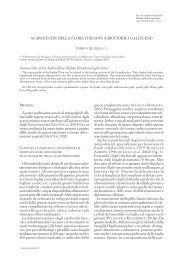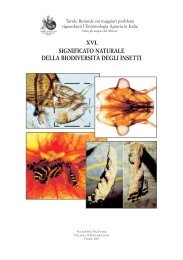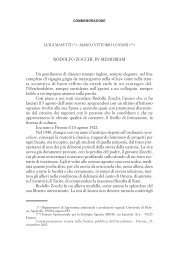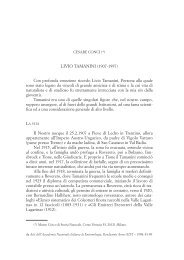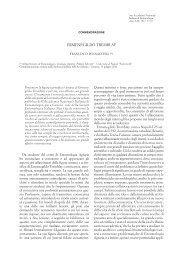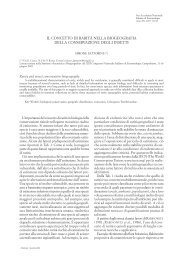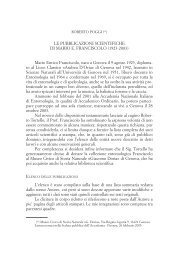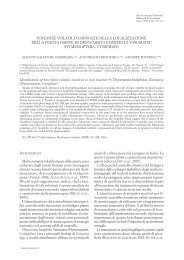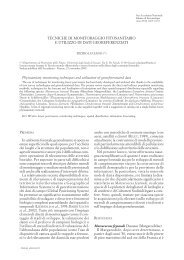XXII CNIE - Accademia nazionale italiana di Entomologia
XXII CNIE - Accademia nazionale italiana di Entomologia
XXII CNIE - Accademia nazionale italiana di Entomologia
Create successful ePaper yourself
Turn your PDF publications into a flip-book with our unique Google optimized e-Paper software.
WHERE DID INSECTS COME FROM? NEUROPHYLOGENETICS, AND THE<br />
ORGANIZATION OF INSECT BRAINS<br />
Nicholas Strausfeld<br />
Center for Insect Science and Division of Neurobiology, University of Arizona, Tucson<br />
This lecture will consider the pe<strong>di</strong>gree of a specific class of brains: namely, the brains of<br />
insects in relation to those of other arthropods, in the context of asking from what<br />
ancestral lineage might the insects have emerged. This question is not yet resolved even<br />
though molecular phylogenetics using nuclear DNA proposes a close affinity between<br />
the Insecta and Entomostraca, a basal group of crustaceans (Mallatt and Giribet, 2006).<br />
However, this view gives rise to some awkward enigmas, not the least of which is that a<br />
group of crustaceans known as the Remipe<strong>di</strong>a emerge as a sister group of the<br />
Entomostraca (Regier et al., 2008). The remipedes are fascinating animals. Each<br />
segment is homonomous, equipped with identical appendages except those of the head.<br />
Remipedes look primitive, and because of this they have been classified as a basal group.<br />
The problem with this interpretation is that neuroanatomical stu<strong>di</strong>es by Fahnenbruck and<br />
Harzsch (205) on one species of Remipe<strong>di</strong>a, demonstrate beyond any doubt that these<br />
animals are equipped with brains that have all the features expected of a higher<br />
malacostracan crustacean, apart from the absence of optic neuropils. This deficit is<br />
hardly surprising because these crustaceans are troglodytic, living in pitch dark in caves.<br />
That the thorax and abdomen of these strange crustaceans are organized almost<br />
homonomously is likely to be a secondary adaptation to an environment in which<br />
specialized limbs for fee<strong>di</strong>ng, locomotion, or defense are redundant.<br />
More recent neuroanatomical analyses that compare insects and crustaceans further<br />
challenge the now widely held opinion that the Insecta are closer to the Entomostraca<br />
(also referred to as the Entomostraca) than they are to the Malacostraca. Phylogenetic<br />
analysis using neural characters suggests that insects are more closely related to the<br />
Malacostraca than to any other group of arthropods and that a common ancestor of the<br />
Malacostraca and Insecta is likely to have possessed features typical of extant basal<br />
malacostracans, such as the Phyllocarida. However, before summarizing the evidence as<br />
to why this is a plausible relationship, I must first outline how brain characters provide<br />
useful and stable in<strong>di</strong>cators of phylogenetic relationships and how such characters are<br />
used for cla<strong>di</strong>stics, the reconstruction of phylogenetic relationships.<br />
The first attempts at using brain structures to infer evolutionary relationships was by two<br />
Swe<strong>di</strong>sh scientists, Nils Holmgren, in 1916 and Bertil Hanström (his student) in 1926.<br />
These authors compared brain regions across the arthropods, focusing on such wellknown<br />
structures as the optic lobes, mushroom bo<strong>di</strong>es, and ocelli. Although insufficient<br />
by today’s standards, these authors came to the conclusion that insects are the sister<br />
group of the crustaceans, a view that was revolutionary at the time and which has only<br />
come back into vogue in the last ten to fifteen years.<br />
Today, many more characters are used for phylogenetic analysis. These relate to six<br />
types of morphological entities. These are, first, architectural criteria that can be applied<br />
to circumscribed neuropils; next, the morphologies of neurons themselves, such as<br />
whether nerve cells within a delineated neuropil are uni- or multistratified, whether they<br />
exhibit polarities, whether they have axons, or are anaxonal, whether their axons cross<br />
segmental domains, whether their axons are homo- or heterolateral, and many other<br />
21



